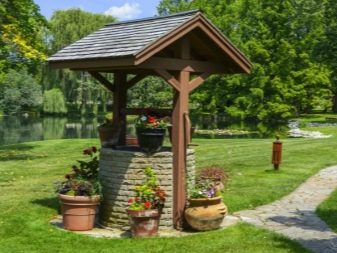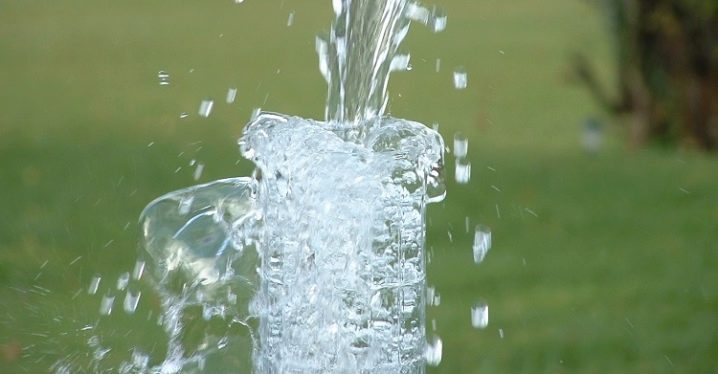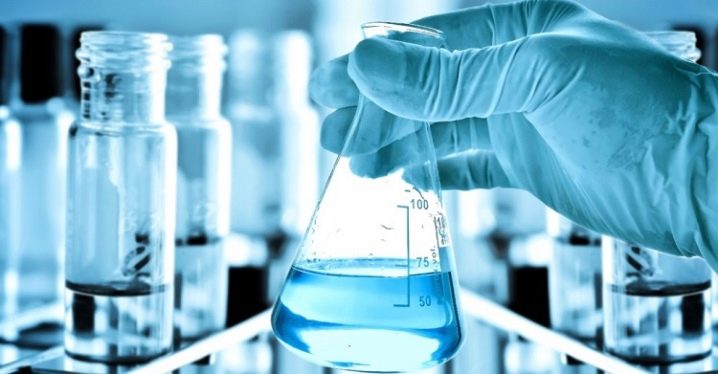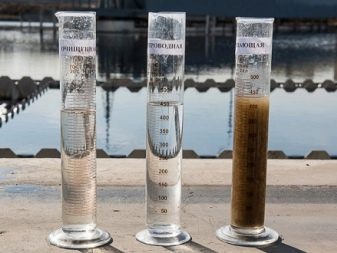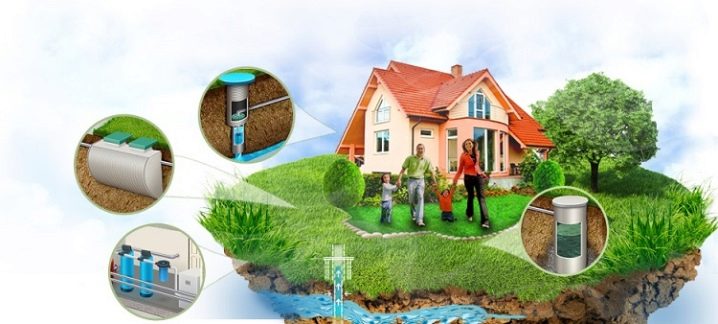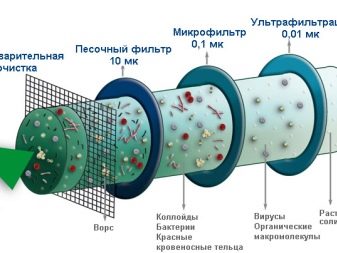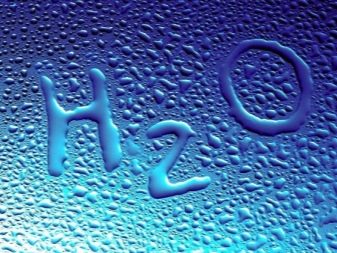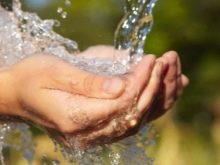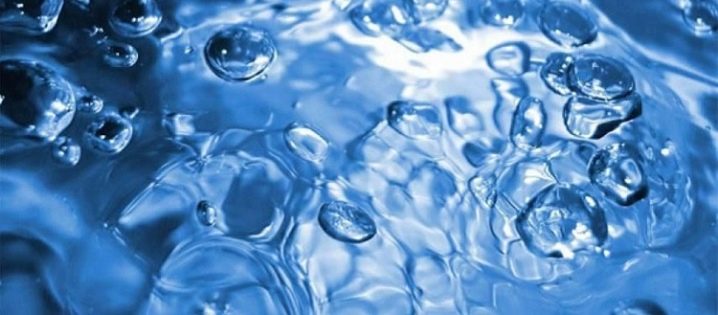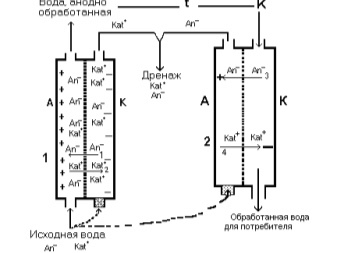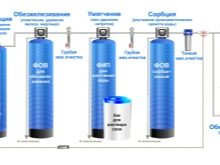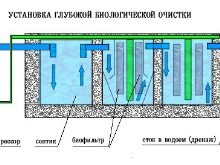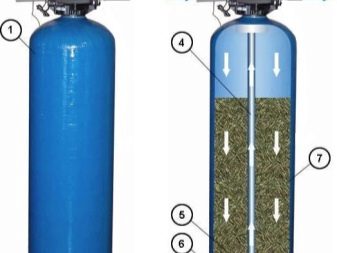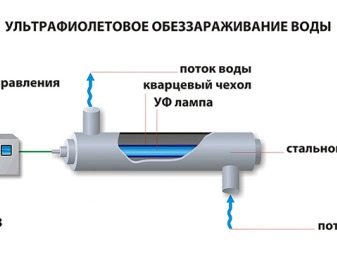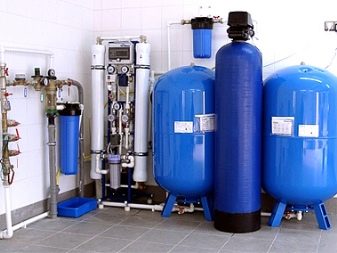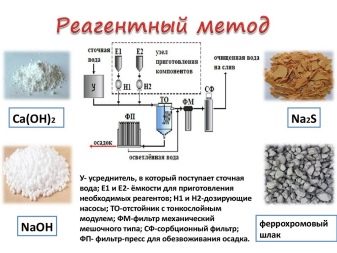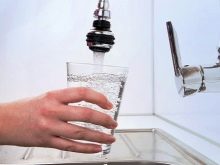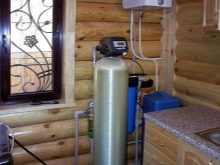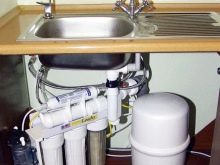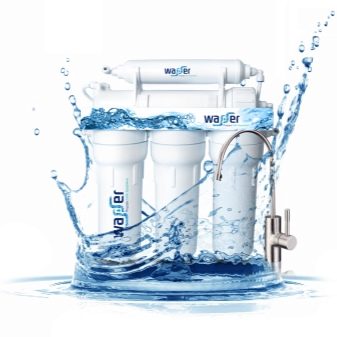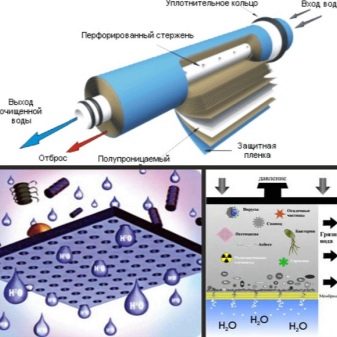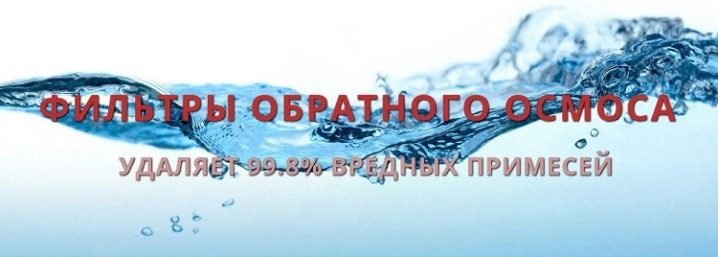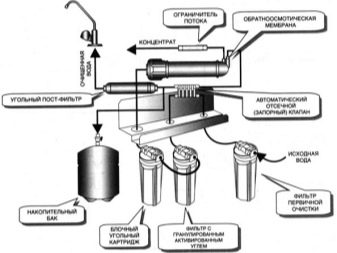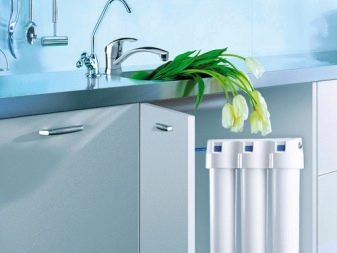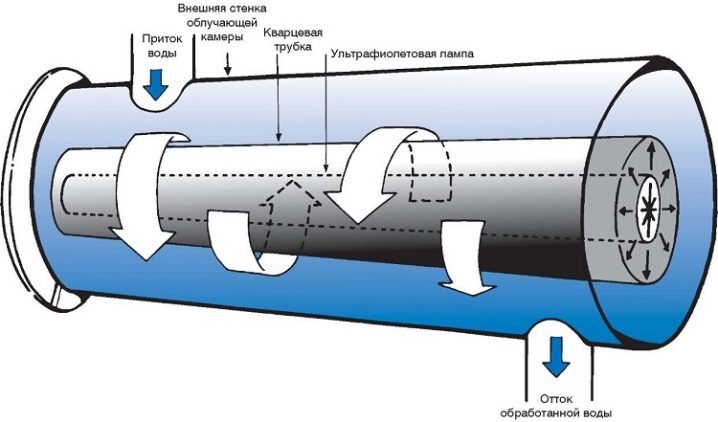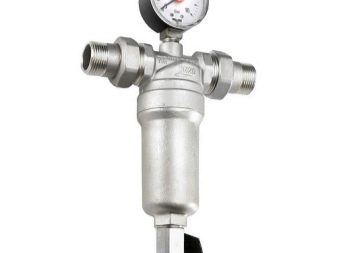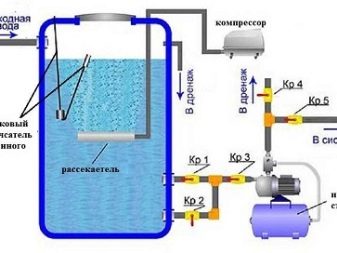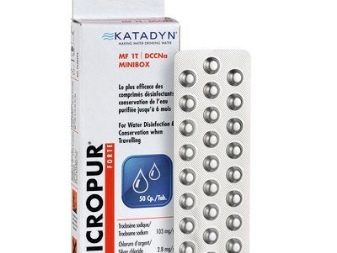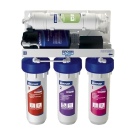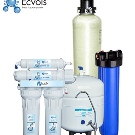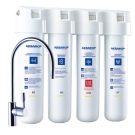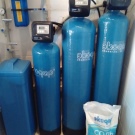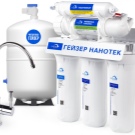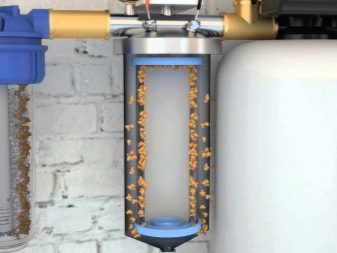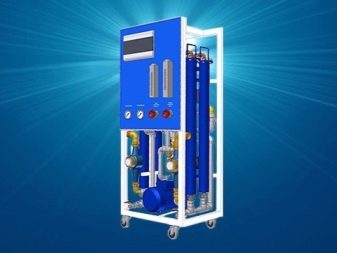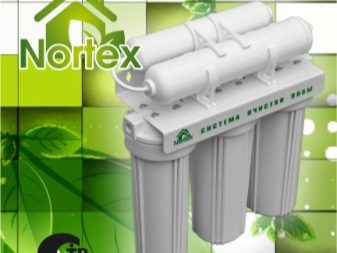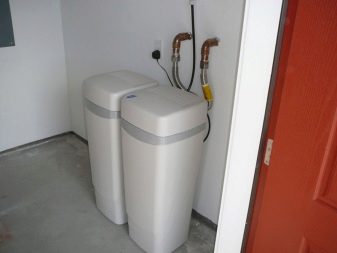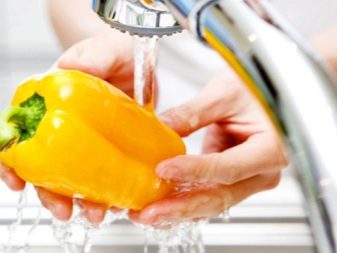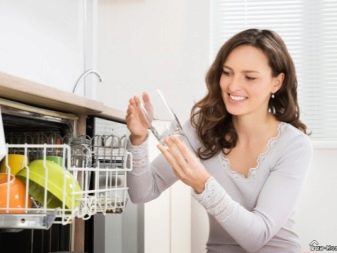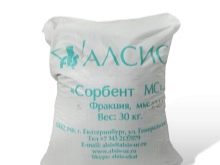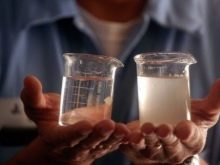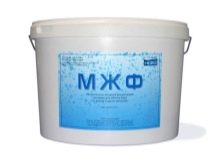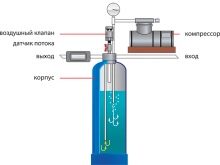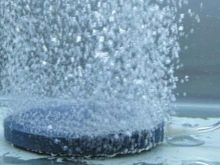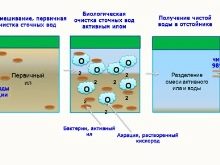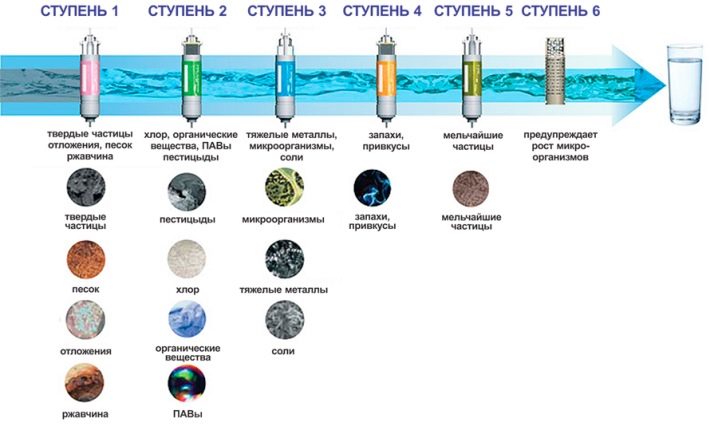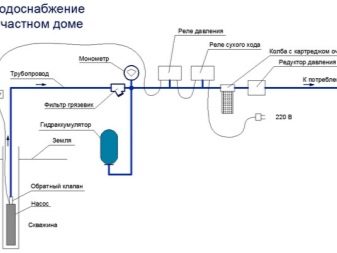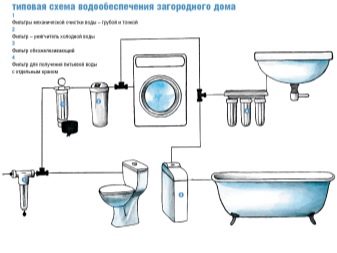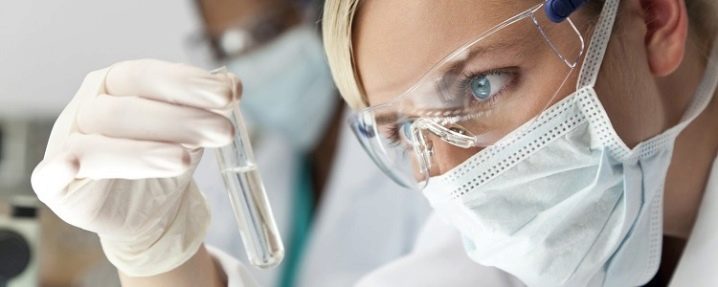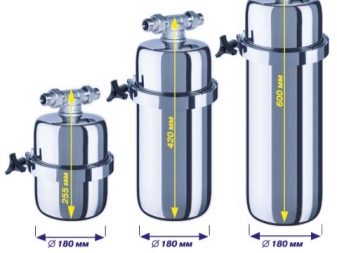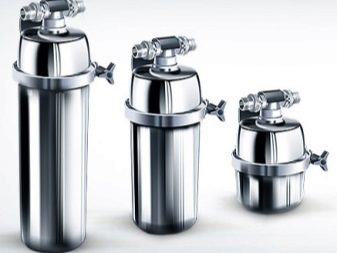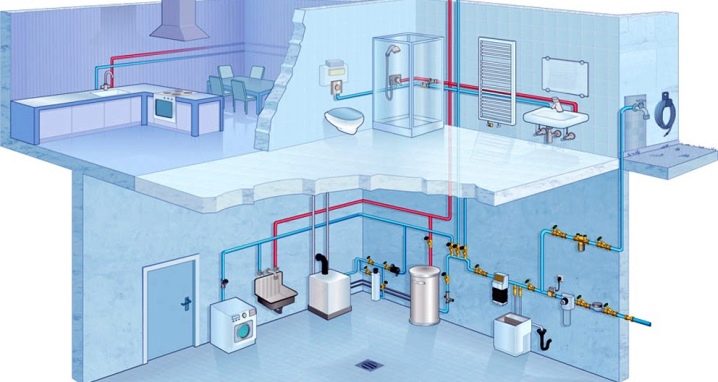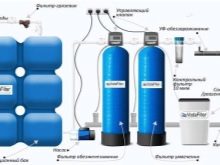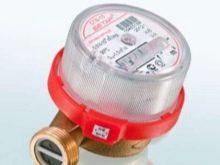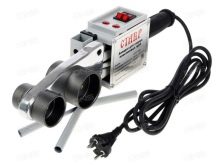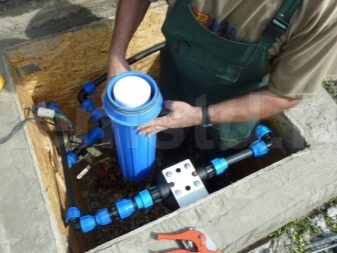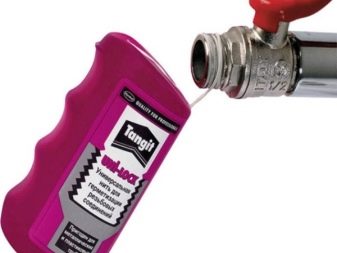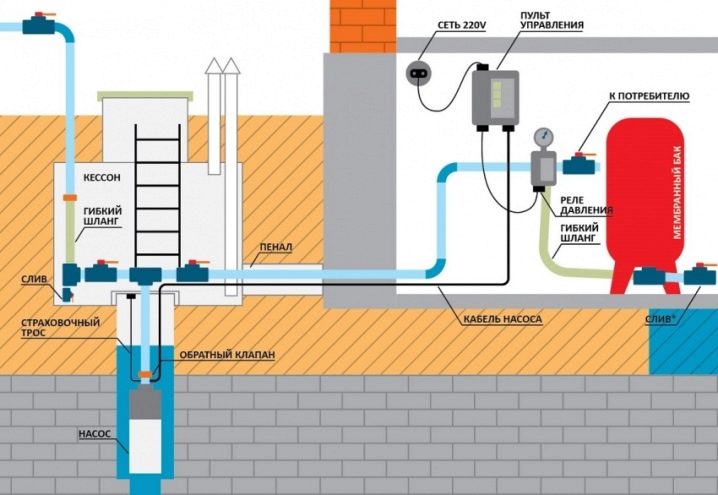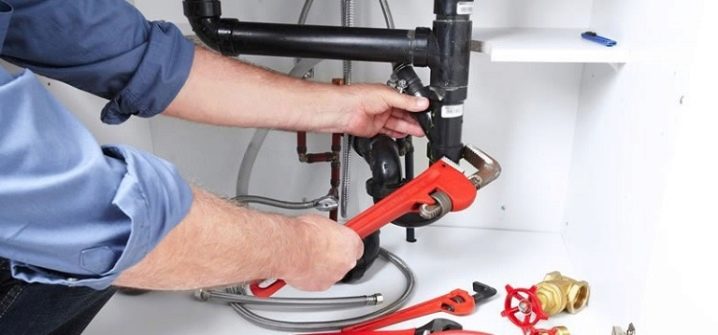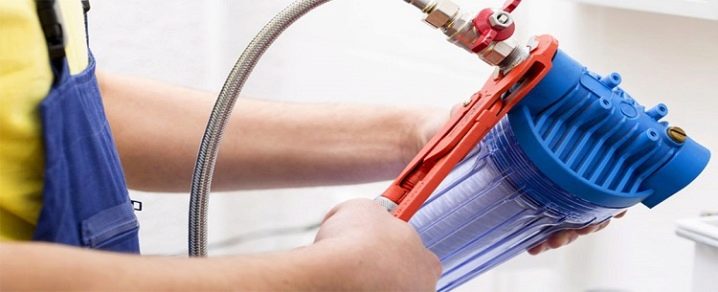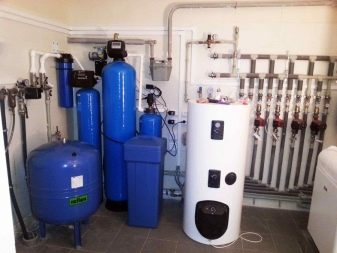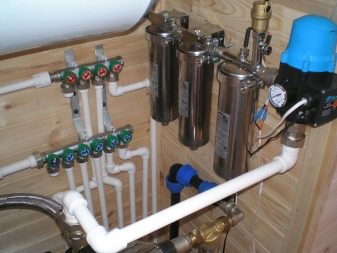Water purification in a country house: choose and install the system

For a comfortable life, we need to have access to services that have long been considered basic and basic to us. One of them is water. The issue of water supply is particularly acute in private homes. As a rule, there the source of water is either a well or an artesian well. In them, the water is not at all as pure as it is mistakenly considered here. Such water is often contaminated with silt and sand.
But if such pollution - it is still nothing. Worse, when the source of water pollution will be bacteria, toxic substances and pesticides that penetrate from the earth into the water. It is logical that the composition of such water will be extremely far from sanitary standards.It usually records a high content of various chemical elements - iron, calcium, magnesium, fluorine, and so on. In high concentrations, these substances are extremely dangerous for humans.
Moreover, this water is dangerous for household appliances. For example, water with a high content of magnesium and calcium will be detrimental to water heaters, boilers, and washing machines due to the formation of plaque on the heating elements of this technology.
Salvation in this case can only be water purification systems. In this article we will talk about what they are, who produces them, and how they differ from each other. In addition, we will touch on the question of how best to choose such a system, how to install it yourself, we will give advice on proper operation.
Special features
To make the choice of high-quality and effective water purification for a private house or cottage, a preliminary laboratory study of water should be carried out. Now this service is offered not only by private laboratories that produce such research, but also by the manufacturers of cleaning systems.
The purpose of the study is to understand what properties water has, and by what indicators there is an excess, and after that select the necessary filter to solve this particular problem.
Tests will show what exactly is contained in water, what percentage of each substance.
The most common problems that private home owners face are:
- increased water hardness due to high concentrations of calcium and magnesium;
- a large percentage of iron;
- the presence of manganese, chlorine, oxidability;
- high presence of salts;
- water color and turbidity;
- various mechanical impurities, as a rule, it is sand or silt;
- water pollution by pathogenic bacteria and pathogens;
- industrial waste pollution.
If we talk about the purpose of the water purification system, then it should be noted:
- improving water quality, not only drinking, but also general use;
- minimization of expenses for maintenance and maintenance of the water purification mechanism;
- simplification and reduction of time for work on the launch of the system at the beginning of the summer season, as well as the implementation of the system conservation process with the onset of frost;
- arrangement of the caisson well and the organization of a convenient connection to the entire system of a high-pressure car wash unit.
The peculiarities of the water treatment system include the fact that they should consist of at least several filters:
- rough cleaning, which will remove sand;
- a filter that will be responsible for water softening;
- fine filter, which will be responsible for the removal of water from heavy metals, nitrates and petroleum products;
- a filter that will disinfect the water, because the bacteria, even in the smallest quantities, but are contained in wells and boreholes.
Safety and quality requirements
If we talk about the requirements for safety and quality of water, they are regulated by SanPiN.
There are three types of water that are mentioned in this document:
- bottled;
- water from open sources;
- plumbing.
Bottled we are not so interested in the context of the issue, but the other two types are worth considering.
So, tap water is regulated by the rules of SanPiN 2.1.4.1074-01. In order for water to be recognized as suitable, it must meet at least 44 indicators, which must be provided by central sewage treatment plants.But given the state of the domestic water supply system, the need for additional water purification before use dictates the importance of installing various water filters at home.
If we talk about water from open sources, then, as a rule, wells give water with a high content of iron, salts, hydrogen sulfide and other chemicals, as well as various bacteria. A simple boil can disinfect water and remove an unpleasant smell, but it will not affect the taste, and they will remain low.
In general, the requirements for water of this category are contained in SanPiN under the number 2.1.4.1175-02. In this document, in addition to the requirements, we are also talking about the norms for organizing the mechanisms of water supply, which use wells as water sources. But here it should be clearly understood that even a well-made water supply system is not a guarantee of the safety and quality of drinking water. In this case, the problem is solved only by installing a modern water treatment mechanism.
Continuing with the topic of requirements, we say that cleaning requires a serious and, most importantly, multi-stage filtration system.
As a rule, it consists of 5 basic mechanisms:
- mechanical cleaning;
- electrochemical;
- sorption purification;
- biological treatment;
- catalytic clarification.
The first type is also called coarse cleaning. Its essence is that such filters are a fine-mesh mesh that retains particles of sand, silt and other mechanical impurities. The second category is also called aeration. Aeration columns are designed to remove hydrogen sulfide, iron and manganese from water. Through this process, water is saturated with oxygen, which reacts with iron and oxidizes it.
Next is iron removal. That is, we are now talking about water turbidity. Iron, dissolved in water, can notice each, as it gives it a rusty color and forms a precipitate. Such water can be purified using filters whose action is based on an oxidation reaction.
That is, a special substance oxidizes iron, after which it is transformed into a precipitate and is filtered out. To soften the water, filters are used that contain ion exchange resin. When water passes through a similar filter, the ions of magnesium and calcium from the water are replaced by the sodium ions contained in the filter filler.
Water softening is also possible under reverse osmosis filters, in which water passes through a series of thin membranes that only allow water molecules to pass through. Such filters not only soften water, but also purify it from bacteria.
Sorption purification is necessary due to the fact that a number of toxins and harmful impurities are not retained by coarse filters. This type of cleaning is built on fine-meshed membranes and sorbent bedding.
The last is disinfection. In this case, harmful microorganisms are destroyed using filters based on ultraviolet light. This technique is safe for human health and does not spoil the taste of water.
Kinds
If we talk about the categories of water treatment systems, Systems are divided into two categories: non-reagent and reagent. At the base of the second are special oxidizing substances that react with the pollutant. The cost of such systems is low, but they require certain costs during operation - to maintain their efficiency at the same level. They can be used to prepare water that cannot be used for drinking.
But the basis of the first reagents are not.Such systems are generally more modern. They have a higher cost, and are also distinguished by the presence of an aeration column and an air compressor. But in this case there are no operating costs, and if viewed from a long-term perspective, they are more profitable. Yes, and such filtration systems can easily transform almost any water into drinking water.
But also if you look at another criterion, then water treatment systems are different. The sorption models, which were written above, are made in the form of jugs containing activated carbon as a cleaning element. The main disadvantage of such a filter for drinking water is its small volume. And the filter should be changed every time after 200 liters of water have passed through it. If this is not done, the carbon filter can be a source of pollution.
Another option filters - flow. They are considered one of the most common.
According to the method of installation, they are usually divided into three categories:
- attachment on the crane;
- station that connects to the mixer;
- station, which is installed in the water supply system.
Such household filters as well as the previous type, contain replaceable carbon cartridges.Their advantage is only in the fact that the filtration volume here is substantially larger and is limited only by the resource of the parts being replaced. The most common filters that are mounted in the pipeline. They are also called cones. Popularity is due to the fact that the presence of several flasks allows you to remove almost all impurities, except bacteria.
Another type is membrane. These are stationary models for water purification, which have a long service life. They can clean up to 75 thousand liters without replacing the elements that are responsible for filtering. The whole secret here will be that the washing of the membrane responsible for filtration is carried out by reverse flow of water. The principle of cleaning is also somewhat different. Its essence is that before entering the membrane, water passes through a number of different cone-type cleaners.
In some models, there is even a procedure for clarifying water using an adsorption technique. On the other hand, such water-purifying models are very bulky.
The next type is reverse osmosis. These filters, which work on the same principle, can be called the best solution available today.Such water purifiers have a rather interesting working principle. Everyone knows that the water molecule is the smallest of all that are presented in nature.
Thanks to technical progress, it was possible to develop a special membrane that allows only water molecules and no others to pass through. Such complex filtering is considered to be very high quality, but it also takes quite a long time. For this reason, each station of reverse osmosis has a special storage capacity.
And the last type, which I want to say - UV sterilization. Such a filter is designed to remove microorganisms from water. The best thing is that thanks to this technology it became possible to completely eliminate the use of chlorine. But this system has a flaw - it destroys only bacteria. That is, it cannot be an independent element, but it can easily become one step in a complex system. By the way, industrial cleaning systems must have this element.
In addition, there are models that are divided by temperature processing properties:
- for hot water;
- for cold water.
It should be said that this is necessary in order to fully purify both streams of water that are supplied to the faucet. The fact is that hot water can contain significantly more elements such as scale, as well as various decomposition products after heating water. At the same time, in cold water there are many impurities that adversely affect human health, as well as the normal operation of various household appliances that work with water.
Filters are also divided according to the type of work and the functions that they perform.
Some models we have already called here, but let's say about them again:
- trunk;
- flow;
- magnetic;
- adsorption;
- reverse osmosis;
- for softening hard water.
It should be noted that the main water treatment systems are mounted directly on the water riser, flow-through mounted under a sink or sink, adsorbent coal - on the riser or under the sink, magnetic - on the water pipe or on the riser, and those that are needed for softening - cascade on the riser, which supplies water.
If we are talking specifically about country houses, then various filtering systems can be used here.For example, household filters will not be effective here. It is necessary to use more complex water treatment technologies that have several steps. For example, now a very effective solution is a combination of aeration and filtration techniques using ion exchange resins.
A variant of aeration causes oxidation of iron and manganese, transforming them into sediment. Ion exchange filters remove hardness salts from water using a process of the same name. Typically, such an installation consists of several tanks that are filled with ion exchange resin. It contains weakly bound sodium ions. When water passes through the resin, calcium and magnesium ions remain in it, and the resin releases sodium ions to water. After a time, the sodium in the resin ends, and its stock needs to be restored.
This requires a sodium chloride solution, which is prepared automatically in a special container, where the salt slowly dissolves in the form of tablets. It is important that the tablets melt slowly, and not disintegrate and not scatter. However, the purchase of such tablets is a serious disadvantage of these filters.
Manufacturers
On the domestic market are products of various companies that are engaged in the creation of the equipment considered in this article.
These are:
- "Barrier";
- Ekvols;
- "Aquaphor";
- "Ecodar";
- "Geyser".
Now let's talk about each in somewhat more detail. The Ekvols company lets out the big range of cleaning systems for country houses. For water purification in a small country house, you can use the filters of the Aquadean Pro line, which are categorized as ion exchange. They are easy to connect. The advantage of these models is that they automatically self-clean.
If you need something more powerful, then you can purchase something from the SKV model line. If there is a well, you can use models from the Comfort and Elite series. And to work with the well there is an excellent model of Dacha, which is based on an aeration cleaner. The price of systems from this manufacturer is in the range from 600 to 1 thousand dollars. The manufacturer gives a five-year warranty on all its products.
Another interesting domestic manufacturer - "Ecodar". This company produces excellent filters for wells called Ecomaster.She can supply them in three trim levels.
As a rule, the components of such a station are:
- aeration column;
- ion exchange softener;
- ultraviolet sterilizer.
If we talk about the price corridor, it is from two to four thousand dollars. The manufacturer gives a guarantee on their models for a period of three years.
Another company whose products deserve attention is Hydrowell. It offers ion exchange resin filters as well as aerators. Usually, such a model will be equipped depending on what kind of water you have to work with, as well as the performance you need. The most popular systems of this company have a simple design. The price is usually 1.5 - 1.8 thousand dollars. The manufacturer gives on their models a one-year warranty.
Filters of the Barrier company are one of the simplest models. Aquadial cleaning systems with ion exchange resin filters and aeration are the perfect solution for use in a country house or cottage. The price here is usually 1.6 - 2.2 thousand dollars. But it should be said that the design of models, frankly, is simple-minded.
If we talk about the models from the company "Geyser", then the most interesting will be a cleaning station called "Geyser-TVT". Such models are commonly used for large volumes of polluted water. For example, they can be used for wastewater. The model we mentioned is a rack on wheels, inside which there is an ion exchange filter column. It allows water purification from most surface sources or artesian wells. It can be used as a person who has a private house, and a person who has a cottage.
The last manufacturer, on which I would like to focus, is Aquaphor. The company produces water purification models using ion exchange filters. For example, the WaterBoss filter line, which is a small softener, in which there is one ion exchange filter, designed for medium-polluted water.
In addition to the main compartment with ion exchange resin, the models of the WaterMax range also have a compartment that contains a sorbent that is best suited for a particular water. If we talk about the cost of these models, the solutions from the Aquaphor Pro and WaterBoss line will cost about one thousand dollars, and WaterMax - about two dollars.The manufacturer gives a guarantee on their models for a period of two years.
But of course, this is an incomplete list of models and manufacturers. For example, interesting solutions are supplied by Brasco and Nortex brands. If we talk about which brand of products will be the best, then it should be said that everything will depend on a lot of factors ranging from the composition of the water to the device at home, as well as the water supply system.
How to pick up?
In order to make the correct selection of water treatment equipment, you must first understand that you are using a well or a well as a water source. The next important point is the properties of water and what contaminants it has. There will already be a question whether it is possible to purify water in living conditions. It should be said that without laboratory research is not enough.
For example, when cleaning well water from various elements of iron ore, it will be better to use special technologies. For example, catalytic oxidation in combination with pre-aeration techniques. And at the final stage, catalyst filtration can be applied. For this, it is easy to use materials like “Sorbent” of MS, MFF, MFI-47 and others.
In addition, if the water from the same well is too saturated with strontium, manganese and iron, it means that it will have a high degree of hardness. Here there is already a need to use a water softener. It will be best used in conjunction with an ion exchange resin filter as a strongly acid cation exchanger.
If the water has an unpleasant smell, similar to the one that have rotten eggs, then it means that the water contains a high concentration of hydrogen sulfide.
The elimination of hydrogen sulfide can be accomplished using:
- water acidification and aeration;
- using aeration devices;
- the use of various ion exchangers to catalyze hydrogen sulfide;
- exposure to organic matter with bacteria, that is, using a biological cleaning method;
- with the use of sulfur oxidants, we are talking about ozone, potassium permanganate, sodium hydrochloride.
In general, as can be seen, the choice of the cleaning system will depend on a lot of factors, namely, the structure of the water supply system, the source of the water supply, and the state of the water itself.
It should be said that manufacturers can offer various types of devices for well and wells.But it is best to use solutions for water purification, which involve one holistic device, including all types of cleaning.
Installation
If you decide to install the water treatment system yourself, then the first step in this process will be to create a system project. That is, it is required to display the plumbing system in the form of a diagram and designate how the pipes go through the house, as well as where the various elements of the water supply are located - pumps, boiler, collectors.
But also, if there is a need, you should put the places on the diagram where the purification filters will be placed. And already on the basis of the prepared plan it is possible to begin calculations of the amount of material that will be necessary for construction.
The next step is to conduct laboratory testing of water. This will allow you to understand what exactly the water is polluted, and then choose the type of filters you need for your house. On the basis of the conclusion that will be issued by the sanitary service, it will be possible to understand exactly what the problem with water is.
Now you can proceed to the selection and subsequent installation of the water purification system. These can be water treatment units, filters, iron removers and other cleaning devices.
The installation of this system is carried out in such a way that water will immediately flow into it after it leaves the accumulator, but before it reaches the tap. Typically, the filters must be located at a distance of 60-120 centimeters from the accumulator.
We will talk about the installation of the system on the example of the Aquafor main filters. This type of filter has a metal case made of stainless steel, and for disassembling and installing replaceable cartridges, unscrew the nut on the metal mounting clamp, which will be more convenient than using a plastic key and case.
The appearance of this filter is quite attractive. The manufacturer notes that such a body will last about 10 years.
There are three models in the series:
- "Mini";
- "Midi";
- "Viking".
They differ only in size and name. But precisely because of the size, each model has its own cartridges. One such cartridge will be enough for the entire summer season. But since cleaning is necessary for different indicators, it was decided to buy two filters with different cartridges. And also spare parts were purchased in case of breakdowns.
At first it was decided that all the pipes would be replaced with polypropylene pipes, and a sump would be installed at the entrance to the system, which could be removed, rinsed and even arranged for sewage. But there will also be installed a water meter to understand how much it is used. In order to carry out the installation, it was decided to use quick-disconnect couplings - the so-called American, which makes it possible to quickly remove any element without any effort and dismantling of the entire system.
The installation of the whole mechanism started with the dismantling of old elements. After that, a mobile shield was fixed on the wall using anchor bolts. Its main task is to be a reliable basis for securing various parts of the water purification mechanism. As a base, which will become the basis for the entire system, the hulls from the main filters of the Viking model were taken. They installed cartridges "Aquaphor" and "Barrier".
At the entrance to the system, it was decided to install a stopcock valve and a Honeywell FF06 coarse wash filter. It is an excellent solution to prevent various particles of rust and sand from entering the water treatment system. Now it was decided to proceed with the installation of pipes.For this, they were fastened with clamps on the walls, which ensured even greater rigidity of the system. And before the main filters was installed water meter model "Ecomera ECO-20." Now it was decided to start welding pipes made of polypropylene. For this, the Stavr ASPT-800 apparatus was used.
To ensure that the threaded connections were reliably sealed, it was decided to use the “Unilok” thread. After the main filters, the pressure regulator of the model “Dzhileks RDM-5” was installed. Its use makes it possible to automatically maintain the pressure of water in the system at a level of 3-4 atmospheres. If the pressure drops below three atmospheres, the regulator automatically turns on the electric pump inside the well.
True, we had to tinker with the issue of connection with the hydroaccumulator, since its output was not located in the same plane as the rest of the system, but significantly extended forward from the wall. For this reason, we still had to purchase several fittings.
When the water treatment mechanism was connected to the hydraulic motor, the plumbing system of the house, it was decided to install a drain pipe from the sump.Drainage systems must necessarily be equipped in houses, because the melted water and rain can cause problems for the owners of private houses.
At the site it will be expressed in puddles and mud, and the basement can be flooded. Water will begin to flush the foundation on the site and spoil the decoration of the building. Yes, and these waters can cause changes in the composition of the water in the well and well. And it can even become unusable.
And to avoid this effect, it is necessary to install a drainage system at the site. Modern systems are resistant to aggressive media and are easy to install, and also have an excellent appearance. Usually their designs are made of various materials. One of the most popular is polyvinyl chloride. It is light, does not crumble, does not peel off and does not even rust. Drains from such material do not need to be painted.
They also do an excellent job with extreme temperatures and are resistant to UV light. A good option would be a model made of steel with a coating of polymers. Steel is a great material and will last for a long time in this case.And also the material from which such systems can be made can be copper.
. Such drains are very wear-resistant due to the fact that during oxidation a patina film appears on the surface of copper.
In general, as you can see, the presence of such a system is simply necessary. In our case, in order to bring the pipe into the sewer system, we took a punch and simply drilled the wall onto the veranda and made a withdrawal through a flexible connection to the tee of the sewer pipe.
At this point, the installation of a new water treatment system and water supply was completed. Now it remains only to start the water in the system. If there are no leaks, you can use it without any problems. And if leaks are observed, then in the place where they are, it is possible to either replace the elements or simply tighten them up.
Tips
We will give various tips on using the water treatment system and its maintenance. For example, there is no need to purify all the water that enters the house. For what purpose do you need clean water, say, in a toilet bowl? The same can be said about the water that we use for washing and washing.That is, in fact, clean water, we need only to drink it and prepare food. It is for this reason that it is better to install water purification systems only in the kitchen. Well, in other places, if somewhere you really need clean water. To use such a system, a small separate tap is provided.
Another tip - for additional protection of the mechanism of water purification from rapid contamination at the entrance of the water supply system, you can install several flasks that have coarse filter elements.
As well as before choosing a sewage treatment plant, one should not neglect the fact that an advanced water analysis should be done in the nearest sanitary laboratory. This will provide an opportunity to determine the most characteristic indicators where there are problems. And besides, it will allow you to carry out an exact selection of one or another type of filter installation, so that the cleaning system is as efficient as possible. If we are talking about the need to install some serious integrated cleaning system, then this process will not be more than entrusted to professionals who already have experience in installing such systems.
The same applies to commissioning works - they must be carried out exclusively by professionals.so that if problems arise they can quickly eliminate them. Another tip - do not neglect the level of coarse water treatment. Its use will make it possible to filter out the largest pollutants and significantly extend the life of special filter systems that will be installed after this type of filter.
If you do not know which company to choose, it will not be superfluous to get acquainted with reviews of products of a particular brand. This will tell you exactly which model to choose. In addition, you can talk with your neighbors and find out which filter systems are installed in their homes, how effectively and efficiently they do their work.
In general, as you can see, choose a system for water purification in a country house can be on a number of criteria. They will be decisive in this process, and in no way should they be neglected. Only strict compliance with the requirements in this matter will provide an opportunity to establish a truly effective and high-quality water treatment system, regardless of whether the well or the well is the source of water.
As for the installation, it is necessary to say that the installation of such a system is rather difficult and troublesome. It's not even about using high-tech filters and devices, but to make the system right, and it gave the desired result. If you decide to install a small cleaning filter yourself, then this is absolutely not a problem.
But if we are talking about some serious and comprehensive cleaning system, then the best thing would probably be to turn to specialists who already have experience in installing such systems. Especially when it comes to the fact that you have never come across such systems before. Or, at least, if you nevertheless decided to install such a system on your own, it would not be superfluous or to consult with a specialist or install at least in his presence, so that if problems arise, they can be fixed promptly.
In the next video you will find the installation of water purification from the well for the house.

